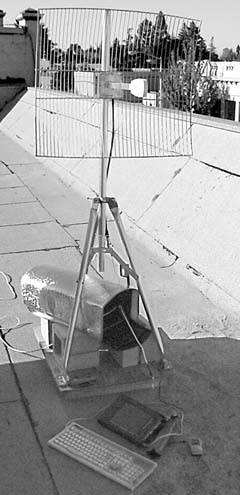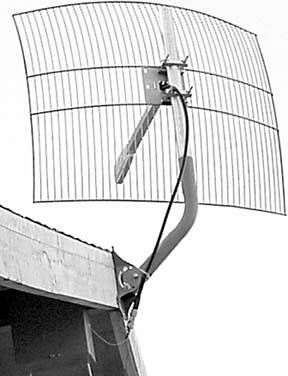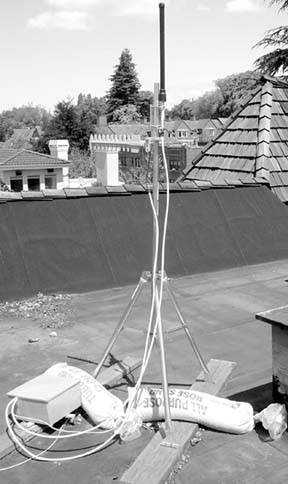Hack 93. Build Cheap, Effective Roof Mounts


Install wireless gear on your roof without piercing it with mounting hardware.
If you intend to build a long distance wireless link, you will likely need to get your antennas up as high as they can comfortably go. For many people, adding a dedicated tower is out of the question (for aesthetic and local ordinance reasons), so the next logical place for gear is the rooftop.
Ideally, the equipment should be installed in such a way that it doesn't pierce the roof of the building, lest the rainy season come and bring expensive roof repair bills with it. If you are working with a flat roof, you may find it useful to build a small sled on which to mount your gear. Figure 6-21 shows a typical plywood sled with a 24 dBi dish mounted on it.
Figure 6-21. Simple plywood sled weighted with cinder blocks

It consists of a piece of plywood that is a few feet square around with sections of 2 4 screwed to it from above. This gets the wood slightly up and off of the roof's surface to allow rainwater to flow past as it normally would. The sled is weighed down with cinder blocks, and has an inexpensive aluminum tripod mount (found at Radio Shack) bolted to it. Figure 6-22 shows a detail of the experimental equipment housing.
Figure 6-22. A rubber mailbox, a cheap and effective solution

In this installation, cost was one of the primary concerns. The owner had a Stylistic 1000 that needed housing, and the cheapest deal we could find at the time was a rubberized mailbox (just a few dollars at the hardware store). When closed, the mailbox is practically water tight, but unfortunately, it has a matte black finish, which will soak up the sun and overheat the electronics inside. This was mitigated by wrapping the box in a cheap Mylar wind-shield reflector, which keeps the inside of the box surprisingly cool, even on hot summer days. Note that the Stylistic has no ventilation requirements, so an airtight box was an ideal choice. The cables were run through a hole cut in the side of the mailbox that was then filled in with silicone compound.
This choice of mounting hardware might sound ridiculous, but you can't argue with this node's uptime: over two years! Granted, this is in Northern California, where the winters are quite mild and the summers aren't boiling too hot. But then again, this node isn't running on a Compact Flash card, but instead uses an eight-year-old PCMCIA hard drive (found installed in the Stylistic when purchased from the local surplus electronics store). We originally installed it just to see how long such a setup would last and were pleasantly surprised at the results. The only downtime this node has suffered has been to upgrade the radio card.
The other end of the link isn't on a flat roof, so we couldn't use a sled. Fortunately, there was plenty of signal available at the pitched edge of the roof, allowing us to use a recycled DSS dish mount. You can see it in action in Figure 6-23.
Figure 6-23. DSS dish mount and short length of pipe

By adding a short piece of pipe, the DSS dish mount was extended enough to accommodate a 24 dBi dish. The metal box beneath the eaves is a $10 metal sprinkler box with an Orinoco RG-1100 installed in it. By bolting directly to wooden studs, we avoided piercing the tar paper on the roof. The two white lines running to the box are Ethernet and power for the RG-1100.
The owner had a considerable amount of Ethernet cable on hand, and decided to run the data separate from power, rather than bother with power over Ethernet [Hack #56]. These cables were later tacked back and run under the eaves, and were virtually invisible from the ground.
Another approach is to avoid the use of plywood altogether and simply make a base out of wide wooden planks, as shown in Figure 6-24. These can be weighed down with sandbags or cinder blocks, and the pole steadied with guy wires if necessary. These materials can be easier to get up on a roof than a sheet of plywood and won't have as much potential wind load.
Figure 6-24. A simpler sled design using two boards and aluminum tripod

If you're curious about the white antenna feed line in the photo, yes, it is in fact Heliax. The omni and yagi terminate in a metal sprinkler box (screwed to one of the boards), which contains a Soekris net4511 [Hack #53]. The Soekris is fed Ethernet and power over a piece of outdoor CAT5, which enters the building through a skylight. The 12 dBi yagi feeds a link to another part of town a couple of miles away, and the 9 dBi omni provides local service.
Another popular choice for roof mounting is the metal chimney mount. This type of mount consists of metal bands that are tightened around an existing vertical structure, such as an unused chimney or metal pipe. This kind of mount requires no additional weight, and makes no actual contact with the roof surface. When using this style of mount, be sure to observe fire codes, and only attach equipment to surfaces that do not heat up.
Roof mounts don't necessarily need to be elaborate. Antennas for 2.4-GHz gear tend to be small and have little wind load, allowing you to get away with surprisingly little for structural support. Whenever working on roofs, remember to take your time, bring a friend, and work only in good weather when you have plenty of daylight. Building your own rooftop node can be very exciting, but remember that roofs can be dangerous places, no matter how many times you have been up on them.
Bluetooth, Mobile Phones, and GPS
- Hacks 122: Introduction
- Hack 1. Set Up Bluetooth on Linux
- Hack 2. Set Up Bluetooth on Windows XP
- Hack 3. Connect Mac OS X with a Bluetooth Phone
- Hack 4. Connect Linux with a Bluetooth Phone
- Hack 5. Connect Windows XP with a Bluetooth Phone
- Hack 6. Use Your Treo as a Modem
- Hack 7. Send SMS from a PowerBook
- Hack 8. Remote Control Mac OS X with Bluetooth Phones and PDAs
- Hack 9. Remote Control Linux with a Bluetooth Phone
- Hack 10. Control XMMS with Bluetooth
- Hack 11. Liven Up Parties with a Participatory Slideshow
- Hack 12. Send SMS from Linux
- Hack 13. Remote Control Windows with Bluetooth Phones and PDAs
- Hack 14. Control Your Bluetooth Phone with FMA
- Hack 15. Control Your Computer from Your Palm
- Hack 16. Control Your Home Theater from Your Palm
- Hack 17. Choose a Cellular Data Plan
- Hack 18. Blog from Your Mobile Phone
- Hack 19. Get Google Maps on Your Mobile Phone
- Hack 20. Share Your GPS
- Hack 21. Broadcast Your GPS Position
- Hack 22. Map Wi-Fi Networks with Kismet and GPSd
Network Discovery and Monitoring
- Hacks 2339: Introduction
- Hack 23. Find All Available Wireless Networks
- Hack 24. Discover Networks with NetStumbler
- Hack 25. Detect Networks with Handheld PCs
- Hack 26. Find and Join Wireless Networks with AP Radar
- Hack 27. Detect Networks on Mac OS X
- Hack 28. Scan Passively with KisMAC
- Hack 29. Detect Networks with Kismet
- Hack 30. Monitor Wireless Links in Linux with Wavemon
- Hack 31. Analyze Traffic with Ethereal
- Hack 32. Track 802.11 Frames in Ethereal
- Hack 33. Watch Network Traffic
- Hack 34. grep Your Network
- Hack 35. Check Wi-Fi Network Performance with Qcheck
- Hack 36. Estimate Network Performance
- Hack 37. Get Real-Time Network Stats
- Hack 38. Graph Your Wireless Performance
- Hack 39. Find Radio Manufacturers by MAC
Wireless Security
- Hacks 4051: Introduction
- Hack 40. Stop Moochers from Stealing Your Wi-Fi Bandwidth
- Hack 41. Visualize a Network
- Hack 42. Secure Your Linux Network with WPA
- Hack 43. Control Wireless Access by MAC
- Hack 44. Authenticate Wireless Users
- Hack 45. Forward Ports over SSH
- Hack 46. Proxy Web Traffic over SSH
- Hack 47. Securely Connect Two Networks
- Hack 48. Generate a Tunnel Configuration Automatically
- Hack 49. Poll Wireless Clients
- Hack 50. Interrogate the Network
- Hack 51. Track Wireless Users
Hardware Hacks
- Hacks 5262: Introduction
- Hack 52. Add an External Antenna
- Hack 53. Do-It-Yourself Access Point Hardware
- Hack 54. Boot from a Compact Flash Hard Drive
- Hack 55. Increase the Range of a PowerBook
- Hack 56. Send Power over Your Ethernet
- Hack 57. The NoCat Night Light
- Hack 58. Upgrade the Linksys WET11
- Hack 59. Scan for Wireless Networks Automatically
- Hack 60. Backlight Your Zipit
- Hack 61. Unwire Your Pistol Mouse
- Hack 62. Mobilize Your WRT54G with the WiFiCar
Software Hacks
- Hacks 6382: Introduction
- Hack 63. Build Your Own Access Point with Linux
- Hack 64. Bridge Your Linux AP
- Hack 65. Protect Your Bridge with a Firewall
- Hack 66. Filter MAC with HostAP and Madwifi
- Hack 67. Upgrade Your Wireless Router
- Hack 68. Set Up an OLSR Mesh Network
- Hack 69. Extend Your Wireless Network with WDS
- Hack 70. Pebble
- Hack 71. Wall Off Your Wireless
- Hack 72. Run Your Mac as an Access Point
- Hack 73. Run Linux on the Zipit Wireless Messenger
- Hack 74. Capture Wireless Users with NoCatAuth
- Hack 75. Capture Wireless Users on a Small Scale
- Hack 76. Build an Online Community in Your Offline Neighborhood
- Hack 77. Manage Multiple AirPort Base Stations
- Hack 78. Advertise Bonjour Services in Linux
- Hack 79. Advertise Any Service with Bonjour in Mac OS X
- Hack 80. Redirect Brought to you by Bonjour Ads
- Hack 81. Use a Windows-Only Wireless Card in Linux
- Hack 82. Use Your Orinoco Card with Hermes AP
Do-It-Yourself Antennas
- Hacks 8393: Introduction
- Hack 83. Make a Deep Dish Cylindrical Parabolic Reflector
- Hack 84. Spider Omni Antenna
- Hack 85. Pringles Can Waveguide
- Hack 86. Pirouette Can Waveguide
- Hack 87. Primestar Dish with Waveguide Feed
- Hack 88. Primestar Dish with Biquad Feed
- Hack 89. Cut a Cable Omni Antenna
- Hack 90. Build a Slotted Waveguide Antenna
- Hack 91. The Passive Repeater
- Hack 92. Determine Your Antenna Gain
- Hack 93. Build Cheap, Effective Roof Mounts
Wireless Network Design
- Hacks 94100: Introduction
- Hack 94. Analyze Elevation Profiles for Better Long-Range Wireless Networking
- Hack 95. Build a Wireless Network for the Large House
- Hack 96. Establish Line of Sight
- Hack 97. Calculate the Link Budget
- Hack 98. Align Antennas at Long Distances
- Hack 99. Slow Down to Speed Up
- Hack 100. Take Advantage of Antenna Polarization
Appendix A. Wireless Standards
- Appendix A. Wireless Standards
- Section A.1. 802.11: The Mother of All IEEE Wireless Ethernet
- Section A.2. 802.11a: The Betamax of the 802.11 Family
- Section A.3. 802.11b: The De Facto Standard
- Section A.4. 802.11g: Like 802.11b, only Faster
- Section A.5. 802.16: WiMAX Long Distance Wireless Infrastructure
- Section A.6. Bluetooth: Cable Replacement for Devices
- Section A.7. 900 MHz: Low Speed, Better Coverage
- Section A.8. CDPD, 1xRTT, and GPRS: Cellular Data Networks
- Section A.9. FRS and GMRS: Super Walkie-Talkies
- Section A.10. 802.1x: Port Security for Network Communications
- Section A.11. WPA & 802.11i
- Section A.12. BSS Versus IBSS
Appendix B. Wireless Hardware Guide
EAN: 2147483647
Pages: 178
- ERP Systems Impact on Organizations
- ERP System Acquisition: A Process Model and Results From an Austrian Survey
- Context Management of ERP Processes in Virtual Communities
- Intrinsic and Contextual Data Quality: The Effect of Media and Personal Involvement
- Relevance and Micro-Relevance for the Professional as Determinants of IT-Diffusion and IT-Use in Healthcare
